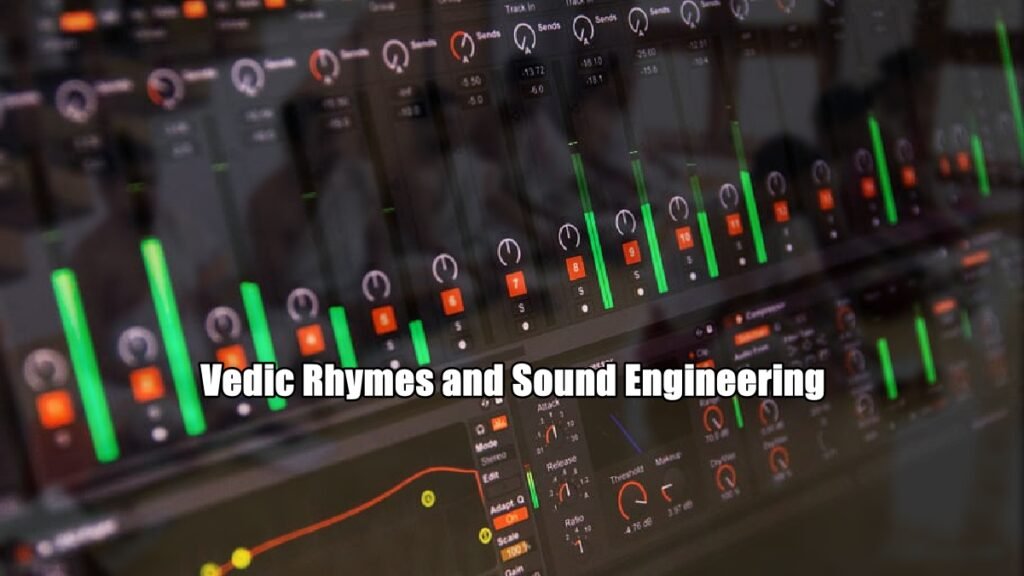Dr. Ashutosh Upadhyay
The Vedic period in ancient India witnessed the birth of a rich tradition of poetic expression. The hymns and verses of the Vedas, the oldest sacred texts of Hinduism, are not only profound in their spiritual significance but also remarkable in their rhythmic and melodic qualities. These ancient Vedic rhymes, known as “Vedic Chandas,” were meticulously composed to create a harmonious and captivating soundscape. In this article, we will explore the fascinating world of Vedic rhymes and delve into the intricacies of sound engineering.
The Structure of Vedic Rhymes:
Vedic rhymes are characterized by their metrical structure and rhythmic patterns. They consist of a combination of syllables, known as “akharas,” which form the building blocks of Vedic poetry. The akharas are organized into defined metrical feet called “pādas.” Each pāda typically contains a fixed number of syllables, ranging from 6 to 26. The Vedic poets skillfully employed these pādas to create mesmerizing rhythms that complemented the content and meaning of the verses.
Types of Vedic Rhymes:
Vedic Chandas can be classified into several categories based on their rhythmic patterns and the number of syllables in each pāda. Some of the most prominent types include:
Gayatri: Gayatri is one of the most revered Vedic meters and consists of three pādas, each containing eight syllables. It is considered the most powerful and sacred meter in Vedic literature.
Anushtubh: Anushtubh is a versatile meter and is commonly used in various Vedic hymns. It comprises four pādas, each containing eight syllables.
Trishtubh: Trishtubh is another significant Vedic meter that consists of four pādas, each containing eleven syllables. It is often employed in prayers and invocations.
Jagati: Jagati is a complex Vedic meter with seven pādas, each containing twelve syllables. It is commonly used in the longest hymns of the Rigveda.
Sound Engineering in Vedic Rhymes:
The composition of Vedic rhymes involved meticulous attention to sound engineering. The ancient sages and poets understood the profound impact of sound on human consciousness and employed specific techniques to enhance the poetic experience. Here are some notable aspects of sound engineering in Vedic rhymes:
Syllabic Patterns: Vedic poets carefully structured their verses with specific syllabic patterns to create rhythmic beauty. They employed variations in the length and arrangement of syllables to evoke different moods and emotions within the verses.
Intonation and Pitch: The recitation of Vedic rhymes involved intricate intonation and pitch modulation. These vocal techniques added depth and resonance to the verses, enhancing their overall impact and making them more memorable.
Chanting and Resonance: Vedic verses were often chanted or sung during religious rituals. The repetitive and melodic nature of chanting allowed for a deep resonance that connected the reciter and the listeners with the divine essence of the hymns.
Pronunciation and Phonetics: The accurate pronunciation of Vedic verses was of utmost importance to preserve the integrity of the sound and meaning. The correct enunciation of each syllable contributed to the melodic flow of the verses.
Mantras and Spiritual Significance: Many Vedic rhymes are considered mantras, sacred sound formulas that carry profound spiritual vibrations. The precise arrangement of syllables and the repetitive chanting of mantras served to awaken and harness spiritual energies.
Preserving and Reviving Vedic Rhymes
The rich heritage of Vedic rhymes holds immense cultural and spiritual significance, making their preservation and revival crucial in ensuring the continuity of ancient Indian traditions. Here are some approaches and initiatives aimed at nurturing and reviving Vedic rhymes for the modern era:
Oral Tradition: The oral transmission of Vedic verses has been a vital aspect of their preservation throughout history. Various gurukuls (traditional schools) and religious institutions continue to impart the knowledge of Vedic recitation and pronunciation, passing it down from generation to generation. This ensures the authentic rendition of Vedic rhymes, maintaining their essence and spiritual potency.
Scholarly Research and Documentation: Scholars and researchers have played a significant role in documenting and studying Vedic rhymes. Through meticulous analysis of ancient texts and manuscripts, they have unraveled the intricacies of Vedic meters and their sound engineering. These scholarly efforts help in preserving the knowledge and disseminating it to a wider audience.
Digital Archives: The advent of technology has facilitated the creation of digital archives, allowing wider access to Vedic texts and recitations. Online platforms provide a repository of Vedic chants, texts, and translations, making them accessible to enthusiasts worldwide. These digital archives not only preserve ancient knowledge but also foster a global community interested in Vedic literature and its sonic beauty.
Academic Programs and Workshops: Many academic institutions offer courses and workshops on Vedic studies, including the recitation and interpretation of Vedic rhymes. These programs provide a platform for students and scholars to delve deeper into the intricacies of Vedic sound engineering, fostering a deeper appreciation for the poetic and melodic dimensions of the verses.
Musical Adaptations and Collaborations: Artists and musicians have recognized the artistic potential of Vedic rhymes and have explored innovative ways to present them to a contemporary audience. Musical adaptations, fusion projects, and collaborations between traditional Indian musicians and global artists have breathed new life into Vedic chants, introducing them to a broader audience and creating a bridge between ancient and modern musical sensibilities.
Cultural Festivals and Performances: Organizing cultural festivals and performances dedicated to Vedic rhymes provides a platform for artists, scholars, and enthusiasts to come together and celebrate this ancient heritage. These events showcase the beauty and power of Vedic chants through captivating recitations, musical renditions, and scholarly discussions, fostering renewed interest and appreciation among attendees.
Vedic rhymes encapsulate the wisdom, spirituality, and poetic brilliance of ancient India. Preserving and reviving these timeless verses and their sound engineering techniques is vital to maintain a connection with our cultural roots and understanding the profound impact of sound on human consciousness. Through oral tradition, scholarly research, digital platforms, academic programs, musical adaptations, and cultural events, we can ensure the continued legacy of Vedic rhymes, allowing their melodies to resonate with future generations and inspire a deeper understanding of our ancient heritage.

